
views
Preparing Your Structure

Plan out your wall. Using string, a level, and a tape measure, plot out the exact dimensions of your wall, enclosure, structure, etc. Having a solid blueprint in place will help your purchase the correct amount of bricks and help you design guidelines that ensure your bricks are laid level. When buying bricks, remember to account for the mortar. Add roughly 1/2" to the size of your bricks to make sure you get the right measurement. However, if the bricks you are buying has a "nominal size," this means that the manufacturer has already added room for mortar. Always buy 10-15 more bricks than you'll need -- some will inevitably break while you're working.
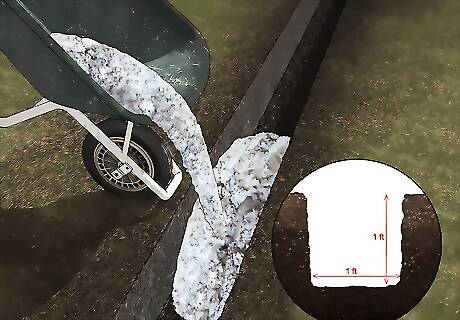
Pour a concrete foundation if you do not have an existing slab, brick ledge, or footing to work on. This must be level and below the grade of the finished ground so that the brick is all you see when your wall is finished. Once it is set, lay a row of bricks out on a "dry run" to ensure that the foundation is the right size. The foundation should be the exact length and height of your brick structure. In general, your foundation should be roughly 1 foot deep before you add the concrete. The concrete needs 2-3 days to set, so you can use this time to set up your guides and round up supplies.
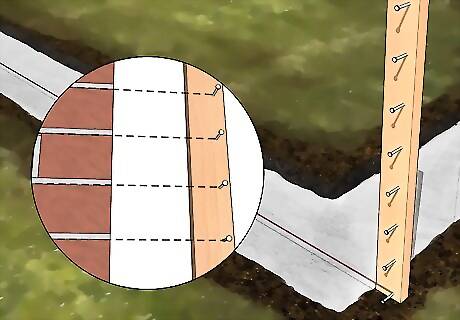
Make your guideposts. This is most important if you are building a wall, but you'll need to create guideposts no matter what you're making to ensure that evenly lay the bricks. To make them, take 2 long wooden boards and drive them into the ground right at the ends of your structure. Starting with the surface of your foundation, mark the height of each brick, as well as the space for the mortar, using a tape measure. Make sure that the two boards are marked equally so that you have a straight line to guide you as you lay the bricks. The architectural standard for brick is ⁄8 inch (1.0 cm) mortar joint thickness on all sides. There are exceptions, of course, for queen, old Chicago, and custom brick.
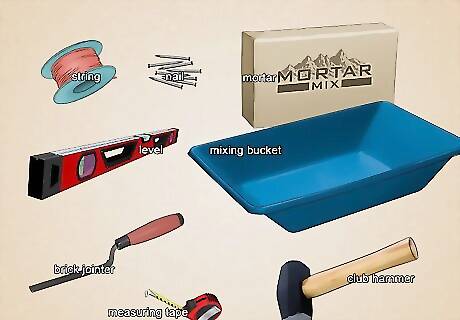
Gather all the materials you need to start your project. Once you have mixed the masonry cement and started laying brick, you have to use all the mortar and strike your joints before quitting. Mortar will harden overnight, so only mix as much as you can manage. Once you're concrete foundation has set and you're ready to begin, you should place the following supplies close by so you can work efficiently: String and clamps/nails (to create guidelines). Mortar and a mixing bucket. Level. Brick jointer. Club hammer (to break bricks in half) Tape Measure.
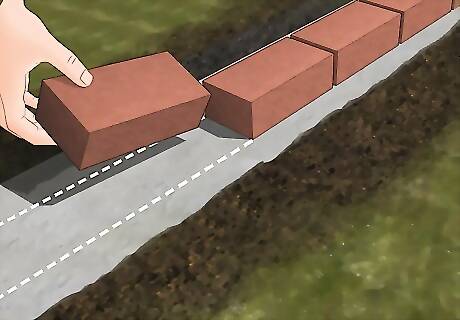
Lay out the first row of brick dry to get an idea of adjustments that need to be made. If you do not lay out the first row of bricks dry, small adjustments will be difficult or impossible to do later, and may cause some noticeable imperfections. You can also make marks on the foundation with a permanent marker and it will make laying down the first course of bricks and centering the bricks much easier. If you purchase new bricks that are 8 inches in length, make marks on the foundation every 22 centimeters. If you are re-using old bricks that are 8 1/4 inches in length, make marks on the foundation every 22.5 centimeters.
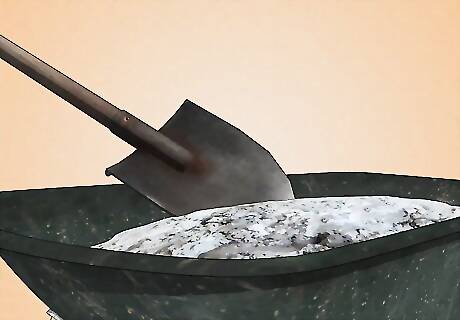
Mix your masonry cement, or mortar. This can be done in a wheelbarrow for small projects, or a mortar box if you don't have access to a mortar mixer or cement mixer. Basically, to mix the mortar, you will use a ratio of three parts masonry sand (builders sand, if it is very clean), to one part masonry cement. Add water to the dry materials and mix to a consistency like pudding. Too dry, and it will be difficult to "set" the brick in the mortar bed, too wet and the brick will sag. If you are starting, you might find it easier to mix a small amount of mortar for just a few bricks; this way, you can add mortar or water, as you go to get the right consistency. If you put a small spatula in the bag of mortar, you can use it to add some mortar, mix, check consistency, then add some more, mix and check consistency. This way you can avoid a watery mix of mortar that lets the bricks sag unevenly.
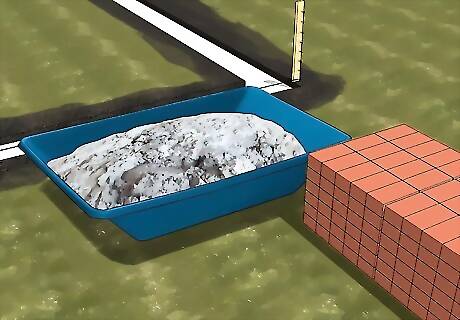
Place bricks and "mortar boards" along your foundation so that you can reach easily them your work area. Place some mixed mortar on plywood so that that it can be reached easily. This will allow you to grab mortar with your trowel as you work, and not have to move around too much. If you've planned correctly, you can also place stacks of bricks at regular intervals so that you can keep working smoothly. However, if you're only working on a small project, you may be fine with one pile of bricks and a bucket of mortar. Place a few shovels of mortar on each board, splashing the board first with water so the mortar "keeps", or stays wet enough to use.
Laying the First Course

Start at a corner and, using the trowel, scoop up mortar and place a 4 to 6 inch (10.2 to 15.2 cm) wide band on the foundation about 1 inch (2.5 cm) thick. Set a brick down in this "bed" of mortar, and tap it down with the handle of your trowel, until it is level, parallel to the line of your wall, and the edge is plumb. Repeat with 6 or 8 bricks, using the edge of the trowel to cut away the excess mortar that is shoved out from under the brick as you go. You can put the mortar on about an inch and a half thick, and then press it down to about a finger's width. Then wipe off the excess with your finger, giving it the classic indention look that you see on brick houses. In masonry, a course is a row of bricks.

Add 3/8" of mortar to the end of the brick and attach another. Keep placing your bricks down on the foundation, joining them with a slab of mortar on the ends. Use the trowel, or your fingers, to wipe up any excess and use it to start the next row.
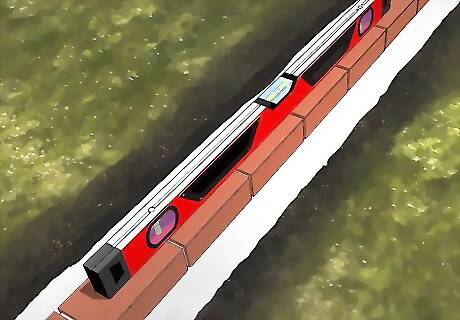
Use a spirit level to ensure that the first row is evenly placed. You can make small adjustments while the mortar is still wet, so carefully use a level to make sure that you have a good, even base to your structure. Check every 4-5 bricks for the best results. A good, even wall comes from good, even mortar. Checking quickly will help you correct your work as you go, getting better results each time.
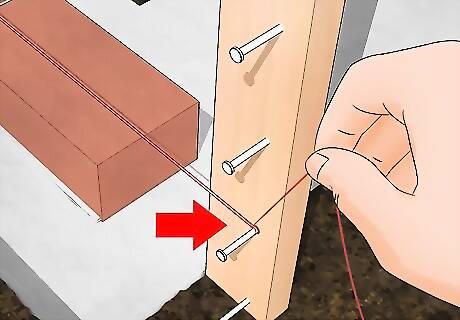
Set your guidelines along the first course. Once you've finished the first row, clamp or nail a string between your guideposts telling you the height of the next row of bricks. You may have to adjust your guideposts slightly so that they start with your first row of bricks, but every other measurement after that should be the same. Make sure your line is tight. You can use a level to check it's straightness. You'll be moving this line after every course of bricks.
Laying Bricks
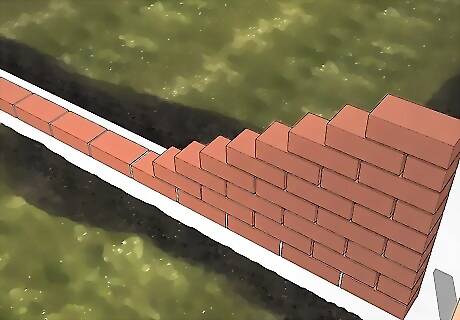
Place down several courses on each end of the wall. These are the "leads." You can then attach a piece of builder's line at the top of each brick as you lay up the remaining brick in this wall, keeping them aligned and level. As you work, your wall will look like a shallow "U," moving up 2-3 courses on either side before filling in the middle with bricks. This ensures that you keep each course level.

Stagger the bricks on each course by starting with a half or turned brick. If you are turning the corner you began at, you will set each course half a brick back from the previous course, so that each course is staggered half a brick. If you are turning the corner where you began, put the first brick in the first course so that it is square, and lay a few brick in this direction also. You don't want the joints of your wall to be even or the wall will be weak. You can either break a brick in half and start with a half brick, or turn a brick sideways (if you're structure is two bricks thick) and start with that.
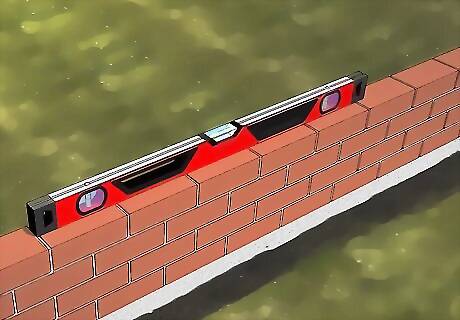
Keep the height of the brick the same using a spirit or carpenter's level, and keep the end joints (head joints) equal as you build up. The standard bed and head joints are ⁄8 inch (1.0 cm), but this can be adjusted to your preference, up to ⁄4 inch (1.9 cm) or even more.
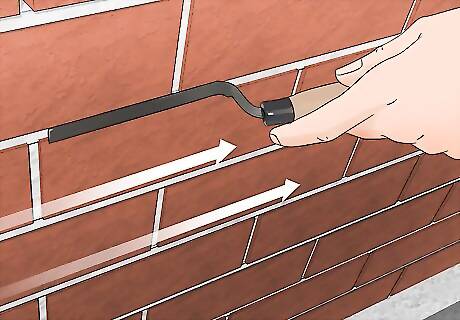
Strike the head and bed joints with a "jointer" or "joint striker" when the mortar has begun to set. The jointer is a piece of tubing whose diameter is the same or slightly larger than your joint spacing, bent in an "S" shape. Hold the tool on one end, and rub it along the mortar joint between your brick with the curved portion of the tool to smooth out the mortar joint. You can also use a wood dowel or a piece of 1/2 inch copper pipe. Both will give you a rounded pattern.
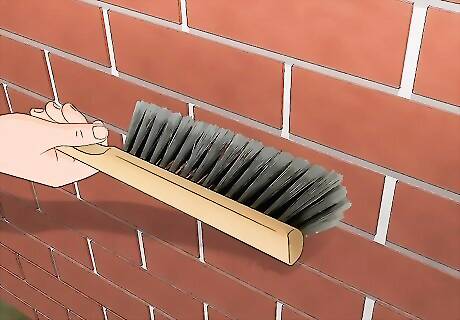
Brush the face of the brick with a "foxtail" brush to wipe away excess mortar and finish smoothing the joint. It takes a lot of practice to be able to tell when the mortar is set properly to strike and brush the joints, but basically, when it is hard enough to touch with your finger and not leave an impression, it is ready.

Continue laying the brick until you are level with the leads you laid up, then begin at the ends or corners laying either in another direction, or straight up with another lead. Once you have this rhythm down, you should be able to move quickly, no matter what structure or shape you're making. The same basic pattern is used the entire time. Move the guidelines. Set the mortar. Stagger your first brick. Wipe away excess mortar. Build up the outsides, or leads, of the wall before filling in the middle.




















Comments
0 comment